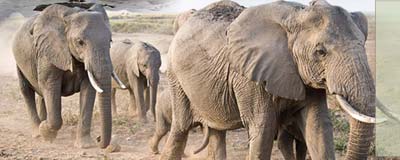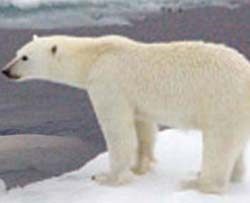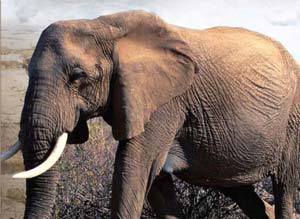|

Each time we do something that has an impact on global warming, we
are drawing one step closer to the extinction of yet another animal
species from Planet Earth; not excluding us. Already many plant and
animal species have disappeared from Earth and the list of threatened or
highly endangered keeps growing day by day. But, we are deaf to all the
groanings and moanings around us; blind to the changing face of the
Earth and complacent (not worried) about the impending danger.
  When
disaster strikes in the form of severe droughts, floods, hurricanes,
rain, snow and dust storms, avalanches and earthquakes, we have only
time to focus on the human needs in such situations. Generally those in
the Animal Kingdom are left to fend for themselves. Even though it is
our careless actions that have made survival such a struggle for them
today, we have little or no time to look into their hard battle to
co-exist with us in this planet, which is their home too - rightfully. When
disaster strikes in the form of severe droughts, floods, hurricanes,
rain, snow and dust storms, avalanches and earthquakes, we have only
time to focus on the human needs in such situations. Generally those in
the Animal Kingdom are left to fend for themselves. Even though it is
our careless actions that have made survival such a struggle for them
today, we have little or no time to look into their hard battle to
co-exist with us in this planet, which is their home too - rightfully.
Loss of habitat due to human development and changing climatic
conditions due to global warming have had a drastic impact on the life
cycle of many an animal. The dwindling forest cover has robbed most land
animals of their rich sources of food, migratory routes and dwelling
places.
Those living in the extreme ends of our planet - the polar bears and
penguins are losing their hunting and breeding grounds as a result of
melting ice caps. The creatures living in the oceans and the skies too
are not spared. Strong wind currents and changing landscapes impact the
migratory patterns of our feathered friends while rising oceanic
temperatures are destroying marine life and thereby all the other
creatures that depend on this marine life for their own survival.
One such land mammal that depends heavily on marine life for its
survival is the huge polar bear. This highly endangered species of
animal, which has today become the much loved symbol in the campaign
against global warming, has to face harsh conditions to exist; its
entire world has been turned upside down due to the melting ice.
Not only is the animal losing the very ground it stands on, due to
the shrinking ice sheets, but also its favourite food, seal and krill.
Polar bears depend on seals and krill and they (seal and krill) survive
on ice. So, when there's a depletion (reduction) in the krill
population, polars lose their food resources.
  Even
their hunting grounds are melting and most often they cannot even hunt
seal pups, another rich source of food for them. When the warming
temperatures result in the breaking up of ice sheets, exposing the icy
cold waters beneath, polars have no firm ground to hunt on. Sometimes
they have to swim great distances to get back on land when the sea ice
is broken. Cold and exhausted, since they have already lost half their
body weight, during the harsh winter, especially the females who have
been nursing their young cubs, the polar bears have no choice but to
risk preying upon walruses. Even
their hunting grounds are melting and most often they cannot even hunt
seal pups, another rich source of food for them. When the warming
temperatures result in the breaking up of ice sheets, exposing the icy
cold waters beneath, polars have no firm ground to hunt on. Sometimes
they have to swim great distances to get back on land when the sea ice
is broken. Cold and exhausted, since they have already lost half their
body weight, during the harsh winter, especially the females who have
been nursing their young cubs, the polar bears have no choice but to
risk preying upon walruses.
The adult walruses are definitely way too big and strong for the
polar bear to attack, especially because they have powerful tusks which
can cause severe injuries, and also because they generally live in large
numbers. What the polar bear aims at is the young ones - the pups which
are generally helpless. But, getting at one is a big battle even for the
polar bear because the adults generally form a defence barrier with
their huge bodies weighing more than 1000kg [p at times. In desperation,
out of unbearable hunger and a need to replenish the fat it has already
lost, the polar sometimes tries to break through such barriers and drag
a pup - but more often than not it ends up seriously wounded. It
eventually has to retreat, heavily wounded and with hardly any energy
left to look elsewhere for food.
With no krill, no seals and no walrus pups, what else can the cute
and cuddly polar bear, we all cherish so much do other than give up on
the battle of life? We are responsible for the death of these cute
bears.
Meanwhile, in Africa, especially in the Kalahari Desert which is a
large arid to semi-arid sandy area in Southern Kgalagadi (Africa),
extending about 900,000 km (362,500 sq. ml.) covering much of Botswana
and parts of Namibia and South Africa, millions of animals are on the
move when the dry season begins in June; they are all on a life or death
quest for food and water.
They travel a great distance in the scorching African heat, amidst
many obstacles such as dust storms and predators to reach the Okavango
Delta, a vast 15,000 square kilometre wetland oasis situated in the
heart of the desert.
With deserts growing in extent every year due to desertification, the
largest land mammals on Earth, the African elephants have been forced to
travel longer distances to get to the Okavango Delta. The trek is long
and exhausting, with many baby elephants and some adults too finding it
beyond their endurance. Some can barely stand on their feet, but they
are edged on by the matriarch, the female elephant leading the herd.
As the oldest and most experienced of the herd, she knows to find the
way to the life-giving delta - the Okavango which is fed by the Okavango
River originating over 800 miles (1,280 km) away in the highlands of
Angola.Following ancient route ways the gigantic mammals march on for
many weeks; blinded by dust storms, exhausted by the scorching heat,
parched without water, they are barely alive. But they drag one foot
behind the other, in the hope of reaching that great water hole which
will surely rejuvenate them once they get there. And how they frolic
once they reach it is a sight to behold.
However, the Okavango Delta will turn into a rich source of water
only if the rains come - And with each passing year, there is a
reduction in the Angolan floodwaters and rainfall due to global
warming.So, with melting ice, increasing deserts, longer droughts, less
rainfall and decreasing food and water resources, how can animals
survive? If you want to save them, then think twice before you
contribute to global warming. It's still not too late to make a
difference!
************
Fast Facts
* The polar bear's scientific name Ursus maritimus means 'sea bear'.
These mammals are often classed as sea creatures.
* Without a solid platform to support their weight polars struggle to
hunt the seals they need to sur vive in the ice sea. Ringed seals are
one of their favourite foods.
* The polar bear is the only animal to spend its entire life in the
Arctic pack ice.
* Male polar bears can grow up to 3 m (10 feet) long and weigh as
much as 10 adult humans.
* Polar bears are expert swimmers and divers. They move through the
water by paddling with their front paws.
* There are two sub species of African elephants; Savanna (or bush)
elephants and forest elephants.
* In the 1970s, there were about 1.3 million African elephants, but
by 2007, the number had reduced to about 690,000.
* African elephants grow up to about 10 feet and weigh over 6.6 tons.
* The Okavango is a unique ecosystem lying in the middle of the
largest continuous stretch of sand in the world - the Kalahari Desert
Basin.
* Kalahari which is about the size of France is one of Africa's last
paradises and the animals that live there include brown hyenas, lions,
meerkats, buffaloes several species of antelope and many types of birds
and reptiles.
* It is one of the most treacherous deserts in the world. |

